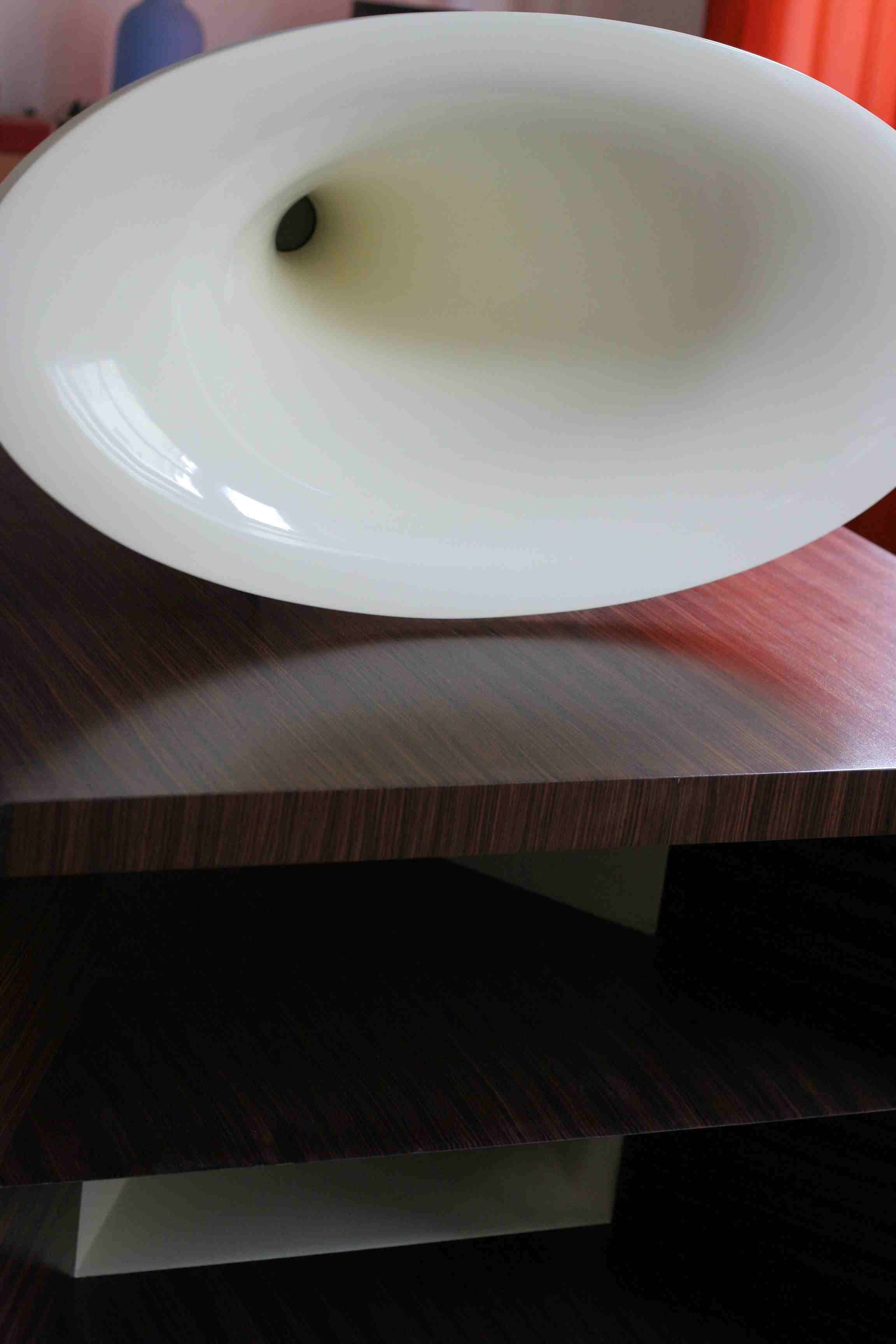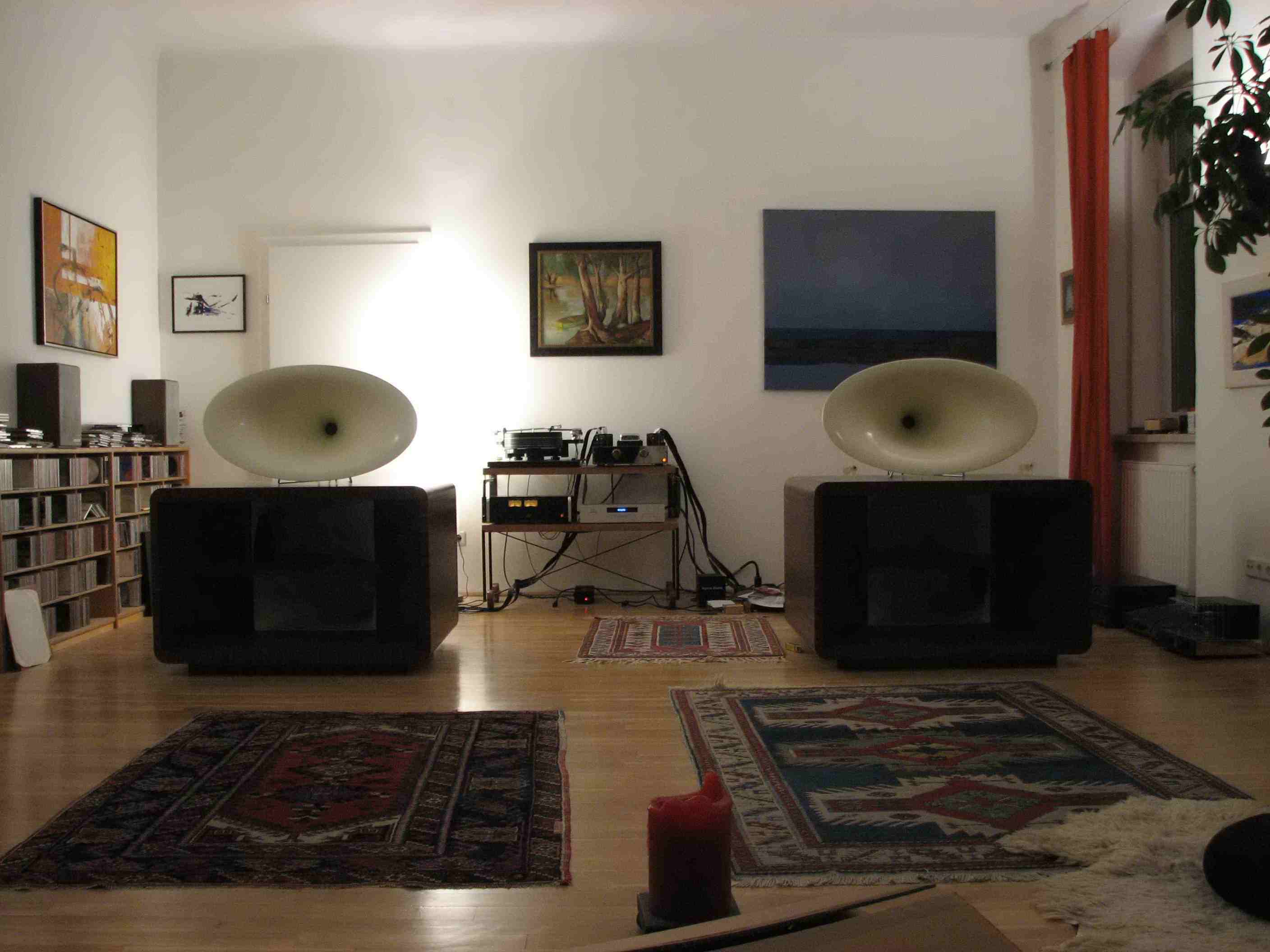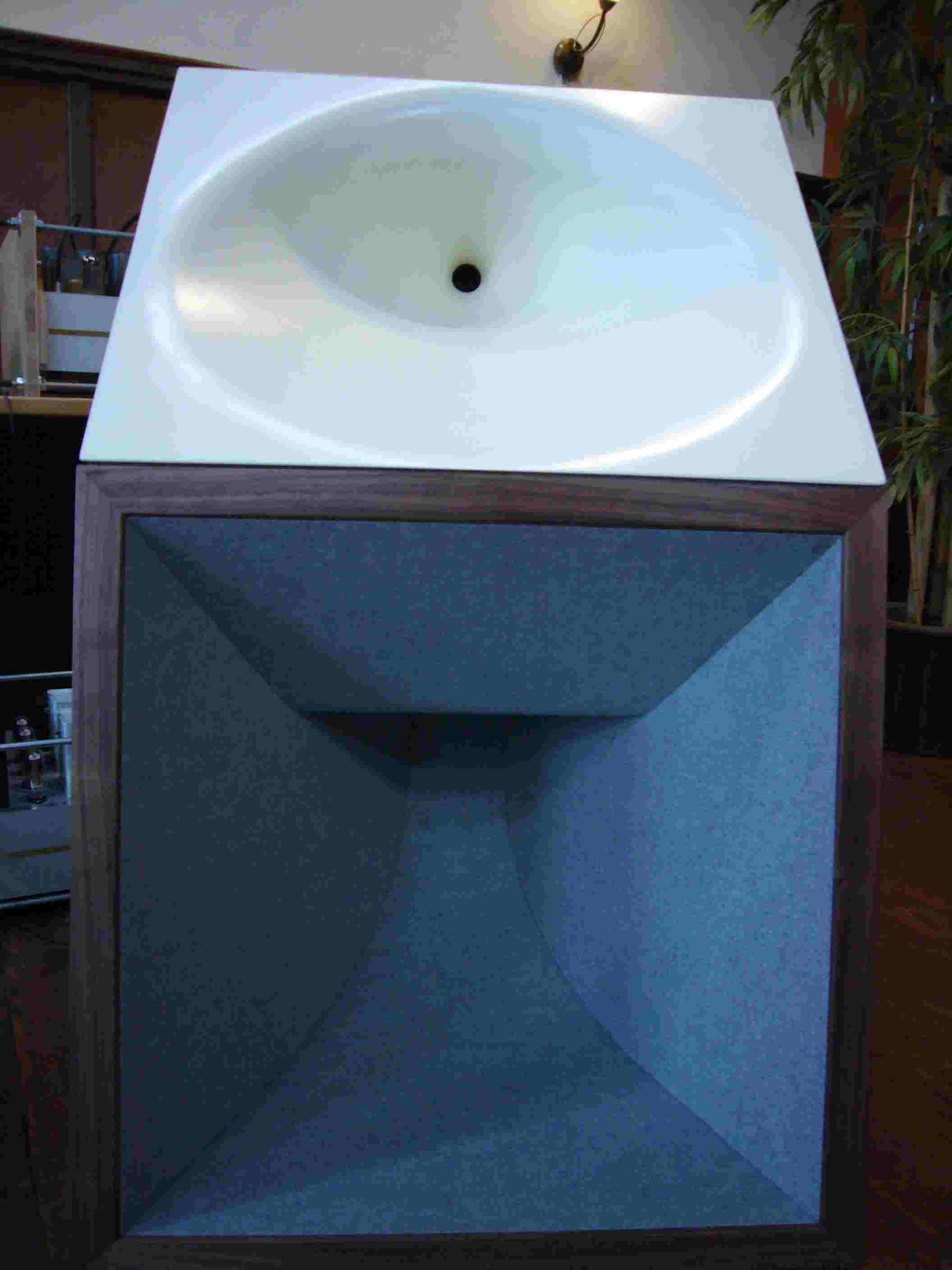

![]()
March 2007 - Haigner Alpha and Beta Horn Systems

In
the last decade, the Single Ended Triode (SET) class A amplifier
revival swept over from Japan to the US and also Europe and became an
important factor in the audio scene. Many audiophiles regard these
low wattage SET amplifiers (normally between 1.5 watts to 20 watts
depending on output tubes used) the only way to really dig into one's
beloved music and enjoy it beat for beat.
Meanwhile
- thanks to some Chinese as well as former East European electronic
manufacturers - it's cheaper than ever to fulfill one's SET amplifier
desire. Brands such as Antique Sound Labs, Cayin Spark, Meixing Audio
and JJ Electronics to name a few, are out there waiting to satisfy
the SET hungry music fans.
An
important and often neglected factor though, to really enjoy all the
musicality, drama and tonal colors a good SET amplifier is able to
deliver, are the matching 'highly sensitive' speakers. By 'highly
sensitive' I mean a speaker with at least > 95 dB efficiency, the
higher the better for a low-powered SET amp. But it's not only the
efficiency which is so important for a pleasurable listening with SET
amps, it's also the impedance curve of the speaker, which 'makes the
difference' in reaching the highest musical satisfaction or not. It's
important to know that this kind of impedance is AC resistance and
changes with frequency, so the impedance curve of a normal
loudspeaker with nominal impedance of 8 ohms is by far 'not a
straight line' (see http://www.churchsoundcheck.com/imp1.html).
The
ideal impedance curve of a loudspeaker connected to the 8 ohm output
transformer tap of a SET amplifier should therefore - over the entire
frequency range of the speaker - be moderate and not drift below 8
ohms, or if so, only slightly and as infrequently as possible
(wishful thinking?). If this can be achieved, your SET amplifier will
show all its virtues (tone colors, drama, musical flow, etc.) and the
musical experience will be breathtaking.
So,
the challenge for a loudspeaker designer, who claims that his/her
speakers are SET friendly, is to provide high-efficiency
speakers with a moderate impedance curve, the latter avoiding
impedance bumps and not dropping below the output impedance of our
beloved SET amps.
That's
where the Austrian loudspeaker-designer David Haigner comes into
play. I have to admit that I have known David for a long time -
I'm proud to call him a friend - and could closely watch part
of his path as a speaker designer, from about 15 years ago, to one of
the most knowledgeable acoustic and speaker experts on this planet
today. I'm not kidding, this guy knows what he's doing damn well. (I
speak from experience, cause I have a pair of high-sensitive,
3-way studio monitors designed by him (see
current system) and they are
superb; we are also in the middle of improving my dedicated music
room acoustically and the absorbers and diffusers he recommended,
calculated and supervised me building, changed my music room
dramatically for the better - it now gives me goose bumps listening
to my beloved records in my music room).
David's
goal for the last 10 years has been to design and develop horn
loaded speakers, which fulfill all his principles and requirements from
-
time-aligned systems with one constant directivity device covering most of the midrange to
-
high-efficiency and moderate impedance curves to let SET amps, as well as low powered Class A transistor amps, really shine.
The
outcome of these 10 years are two full-range horn speaker systems,
the ALPHA and BETA horns (see photos below). For more technical
information, I invite you to visit David's
website (English version will be
available soon!).

Photo
courtesy of David Haigner
(showing
the Alpha horns in the listening room of Austrian distributer Reno
Barth, 'The
Source Audiosysteme', Vienna;
contact: r_b"at"gmx.at)
The
impressive ALPHA horns, a 3-way 'time-aligned' concept (103 dB / W /
m and 8 ohm
imp.)
with 2x 18" woofers in a front-loaded bass horn configuration
and one front-loaded
horn
for mids and treble driven by a coaxial compression driver.

Photo
courtesy of Alex Olzinger (Beta horn at ETF 2006)
The
BETA horn is a 2-way 'time-aligned' concept with front-loaded bass
horn driven by one 15" woofer and one mid / treble horn with a
compression driver (96 dB / W / m and 8 ohm imp.)
Let me tell you now about my listening experiences with these 2 horn speakers:
The
ALPHA horn is a state-of-the-art system and needs a big room (from
35 m2) to deliver all of its musical strength. I had the
chance to listen to it twice at the wonderful demo room of 'The
Source Audiosysteme', Vienna (see photo of the ALPHA horns above) -
the Austrian distributer of Haigner horns, EAR/Paravicini
electronics, Nottingham Analogue and more - in a high-level system
composed of an EAR 912 preamp (source was a Nottingham Dais turntable
with Nottingham Ace-Space Arm and Dynavector XV1 cartridge),
Welborne Labs Moondog 2A3 SET amplification (3.5 watts of power) as
well as EAR 509 Push Pull amps (about 100 watts)
and these speakers 'blew me away' and changed my understanding about
loudspeakers as a whole.
The
listening room of about 60 m2 (approx. 3.5m high) was
filled with music - it felt like 'bathing in a wall of sound'. A
breathtaking experience, definitely the most impressive and joyful
musical performance I've ever experienced. The resolution and dynamic
shading of these speakers are truly amazing - like an acoustic lens -
you can hear with ease, for instance, sonic differences in partnering
equipment as well as differences in interpretations of various
artists performing the same piece of classical music. Piano music -
well recorded - was in no system before more real and accurate,
portraying a piano with almost lifelike realism, be it a Steinway or
a Bösendorfer. Unfortunately, I don't have the
appropriate room or money to afford the ALPHA horns - a real bummer.
The BETA horn, which I auditioned for 3 days extensively at ETF 2006 with various electronics and sources, can be used in smaller rooms (from 25 m2) but also plays in much bigger rooms with lifelike levels. The room at ETF had approx. 100 m2 and we had a lot of fun listening to music with the BETA horns.
These are awesome speakers. Extremely quick and authoritative bass, a wonderful midrange, detailed and sparkling but never fatiguing treble and overall rhythm and flow. These strengths are shown with a variety of music. For example, the intimacy and energy of small jazz ensembles are portrayed in such a coherent and musical way that you are totally drawn into the music and experience it with all your senses.
This would be a perfect speaker for my room and SET amps, but unfortunately for the time being it's not an affordable choice for me. But maybe one day...
In my opinion, both horn systems are amongst the finest currently available loudspeakers and definitely worth their price. Lately, I've been informed by David that he will design a third - more affordable - horn system, the GAMMA horns.
Folks, this could be the speaker for people with lower budgets like me. Can't wait to listen to these babies...
Added
April 07:
At the end of March 2007, I had the chance to listen to the ALPHA Horns one more time for some hours with the same EAR preamp and vinyl source (see info above) but with a Verdier 300B SE stereo amp connected to the ALPHA Horns, and this was an unexpected magical improvement of what I had thought was awesome before. I love the Welborne Labs Moondog 2A3s, especially for their midrange and treble excellence, but what happens when you drive an outstanding high-efficiency speaker like the ALPHA horns with a more powerful SET amp (2 x 7 Watts of Verdier 300B SET magic) is something which has to be experienced firsthand. There was grip in the bass registers, dynamic presence in all sorts of orchestral music, phenomenal tonal shadings and resolution of well-recorded and/or well-performed piano music with a focus on the interpretation of such performances themselves.
My beloved Beethoven Piano Concerto No. 2, for example, performed by Emil Gilels/George Szell & the Cleveland Orchestra on ANGEL Stereo SE-3731 (= set of Beethovens 5 piano concerts) was breathtaking. The ALPHA horns allow total connection with this stunning performance; the incredibly emotional playing of Gilels in the 2nd set, for example, transformed the listener into a devotee. Simply superb...
The ALPHA horns are definitely outstanding speakers and I can't recommend them highly enough. Besides their stunning looks, they will give you superb musical pleasure even driven by budget-level source and amplification devices. However, driven by high-quality equipment (as we auditioned) they deliver goose bumps and a feeling that you're listening to the music live.
To imagine what musical impressions a bi-amping combination of 45 or 2A3 SET amps for the mids and treble section (together with the Verdier 300Bs driving the bass section of the ALPHA horns) would provide could be a music lover's wildest fantasy of the ultimate combination for music reproduction.
David Haigner's ALPHA horns are a statement loudspeaker system and more than a challenge for the big names in speaker design out there.
Musically yours,
Norbert
PS: Hmm, maybe I should sell my car...
Added
September 07:
My
latest listening experiences with the musically-awesome ALPHA horns
were once again at the Vienna demo room of 'The Source Audiosysteme'
and worth a mention. Driven by high class Shindo amplification
(sources were the same as described above) this musical experience
topped everything said above. The gear: a Shindo Catherine dual mono
preamp and a pair of Shindo Talbot single ended mono amps with F2A
output tubes which a friend of David's and mine brought in for a
listening demo (both Shindo products are no longer in production).
The experience: my view of music-reproduction systems in general and
their musical possibilities was completely shattered in the most
positive way. This was closer to the real experience and thrill of
listening to live music than I'd ever experienced before. It's not
possible to describe this performance with words - it has to be
experienced firsthand. It was so real and jawdropping that I forgot
about all the hifi jargon such as detail, timing, flow, dynamic
shading, ambience, pace... you name it. I only listened, emotionally
touched and drawn into the music played, record after record for
hours. My best musical experience from any system I have ever had the
chance to listen to. Period!
A
technical point: The Talbot SE monos have an uncommon output
resistance > 10 ohm which regarding to the 'textbook' should
result in shortcomings driving the pair of 18" woofers
responsible for the low registers in each of the Alpha horns. But due
to a clever crossover design with an close to ideal 8 ohm impedance
behavior in the bass frequency range (very rarely accomplished in
loudspeaker design) there were no whatsoever shortcomings audible!

©The Audio Eagle 2005-2014 • All Rights Reserved • Disclaimer









